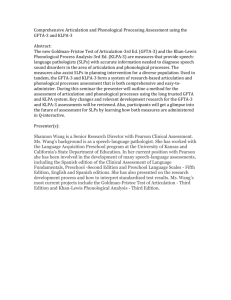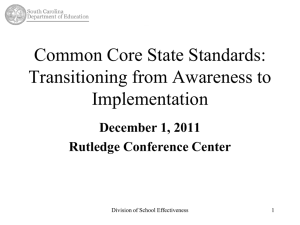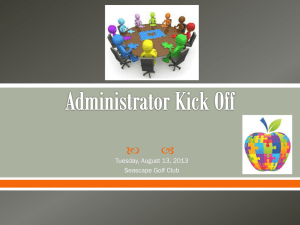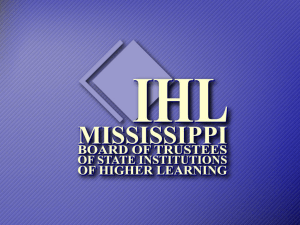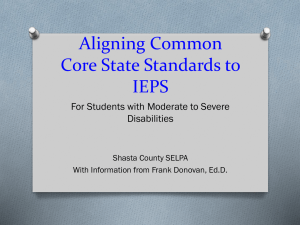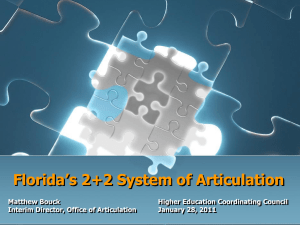File - Speech
advertisement
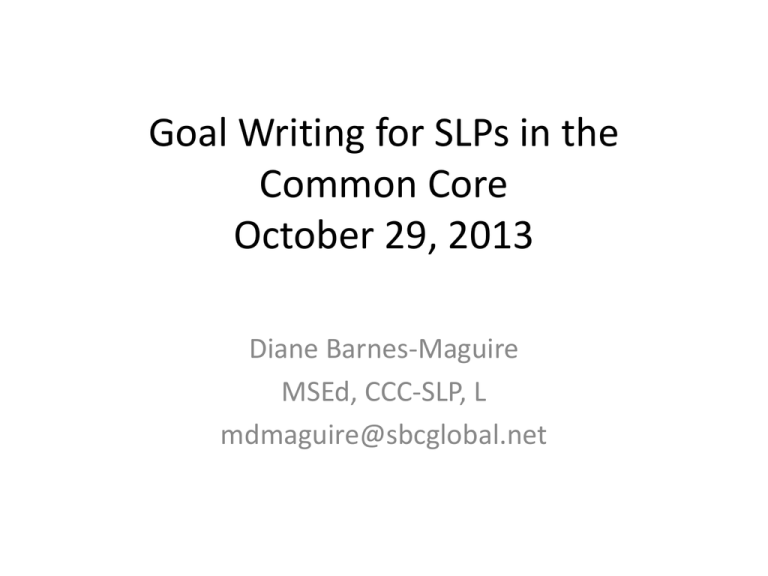
Goal Writing for SLPs in the Common Core October 29, 2013 Diane Barnes-Maguire MSEd, CCC-SLP, L mdmaguire@sbcglobal.net Introductions All in a Day’s Work Snapshot of your average day in therapy: Articulation Pragmatics Phonology Expressive Language Semantics Receptive Language Syntax A.A.C. Fluency Processing Voice Executive Functions Swallowing Written Language How do we Know what to Focus On? • GAN • Greatest Area of Need • The GAN is evident from data regarding the child. • What are our sources of data? • How important is Present Level of Performance? • When do we collect data? And it is Always Changing!!! • Name some changes within the profession that have been implemented since you began. • Now rank those changes to determine which change has had the biggest impact on your duties as an SLP. Don’t let the Paperwork and Regulations Overshadow working with Students! Tools to help you: 1. SMART goals format 2. Common Core Standards charts 3. Technological Advances/Data collection 4. Develop new strategies to align practice with Common Core Standards 5. Networking Working Goals for Today Working in groups, please write down a goal that you typically write (pick one area): a. Articulation b. Grammar c. Vocabulary d. Pragmatics e. Your choice SMART Goals • • • • • Specific Measurable Attainable Results-based/Relevant Time specific Key Components for Goals • Summative = yearly • Formative = quarterly/each trimester • Progress Monitoring = more frequently than quarterly/each trimester • Specific Subject/Grouping noted • Linked to Curriculum Based Assessment/Task Analysis • Linked to Common Core Standard SMART Goal Template • By month/year, when given subject/task at – level, student name will increase/decrease (what we want them to do) from present level to projected level using assessment/curriculum based measurement as measured by schedule (weekly, biweekly, monthly) assessment (nationally normed progress monitoring assessment/criterion referenced assessment) and reported quarterly/each trimester. • Objective: By month/year, using assessment/CBM at –level, student will increase/decrease what we want to happen. (criteria, procedure, schedule) Sample Articulation Goal • By September 2014, when given an articulation probe at the four year old level, Josie will increase the percentage of initial plosive sounds she is able to articulate in 3-6 word sentences from 40% to 70% accuracy as measured by weekly data probes based on a criterion-referenced speech sounds assessment and reported quarterly. Sample Comprehension Goal • By May 2014, when given a sixth grade level informational text discussed in general education subject areas, Eric will increase his comprehension scores from 40% to 70% as measured by monthly curriculum based measurements and reported quarterly. • 7/English Language Arts/ RL/ Key Ideas and Details • • • • • • • • • Only use/change one criteria per goal “As measured by ___ and reported q/t” must be in the goal statement If a student has a functional goal, indicate Activities of Daily Living as the subject Place Summative assessment in the GOAL statement Place Formative assessments in the OBJECTIVE statements Note Progress Monitoring in the Procedure/Criteria/Schedule boxes; must occur more than once per q/t (weekly, bi-monthly, monthly) For speech language therapy (and other related services), the location of the goal worked on can be the subject (during group therapy, during individualized therapy sessions, during general education class, during group class work, etc.) Current level of functioning is stated in the PLOP (Present Level of Performance) statement in relationship to what other students at this grade level are able to do. Goals should address the gaps between what is expected and where the child is currently functioning. • Review all assessment information available on the student (both standardized and nonstandardized) • Collaborate in advance of writing the IEP, including collaboration with the parent and the teachers • You will evaluate strengths and areas of need related to the CCSS What do you think is needed for him to be successful? • If you just copy the CCSS, you are not making an INDIVIDUALIZED goal, you are just rewriting what everyone else is expected to do • You can paraphrase the CCSS and focus on what is needed from Bloom’s Taxonomy (understand, apply, analyze, evaluate, create) in order for the student to be successful • The goals help direct what gaps need to be filled for the student to be successful An Example in Action • PLOP: “ He is able to understand simple synonyms, antonyms, & homonyms but struggles with precise use of grade level vocabulary. He is inconsistent in being able to retell a story and struggles to speak in complete sentences during academic tasks, which affects his ability to write using complete compound and complex sentences.” Our work must support student success in the Classroom! • Create: assemble, construct, formulate, develop, write • Evaluate: justify a decision/argue & defend, judge • Analyze: distinguish between 2 parts/compare & contrast • Apply: use info in a new way/demonstrate, solve, operate • Understand: explain ideas or concepts/classify and describe • Remember: recall or remember the information/define, list Understanding the Common Core Standards & the Relationship to Speech & Language • - Common Core addresses Language Skills Narratives Comprehension Phonological Awareness Conversation/Discourse Grammar Sentence Structure Vocabulary • • • • Language (including Vocabulary) Listening and Speaking Reading Literacy for 6th – 12th grade Social Studies, Science, and Technical Subjects • Writing • Mathematics • Early Learning & Development (Published 10/2013) Standards • Set of shared goals & expectations for what knowledge and skills will help students succeed. • Set the goals for what students should know and be able to do by the time they complete a grade level (and eventually graduate from high school). 3 Components of Standards • 1. Content – what students must know • 2. Process – what the students should be able to do (skill or process => Bloom’s Taxonomy) • 3. Performance – how well the students must perform; complexity Standards establish WHAT students need to learn. Standards do not dictate HOW teachers should teach. • The success will be depend upon how common core standards are used by the special educators. • Through Universal Design for Learning we create goals and interventions for the unique needs of our students. • SLPs are experts in adapting and differentiating curriculum based on students’ needs. • Provide functional accommodations and modifications that are related to the selected goals. How to fit what SLPs do to the Common Core Standards Language Standards -Conventions of standard English -Vocabulary Acquisition and Use -Knowledge of Language (effective use of language and recognition of types of language) -Syntax, grammar, sentence structure, vocabulary, & conversation Listening & Speaking Standards -Comprehension and Collaboration (day to day interaction in small group, larger group, and one-on-one settings) -Presentation of knowledge and Ideas (formally sharing ideas and concepts) -Discourse, pragmatics, describing, retelling, summarizing, presenting, adapting speaking, point of view Reading Standards -Key Ideas and Details -Structure and Crafting -Integration of Ideas and Knowledge -Reading Skill Foundations: print concepts, phonological awareness, phonics and word recognition, fluency -Reading complexity and range -Literature & Information Texts grades 6-12 -Comprehension, narratives, questioning, summarizing, analyzing, inferences, story elements, evaluating, point of view, central idea, theme Aligning Standards with IEP Goals Articulation and Phonology are aligned with Reading Skills: Foundations • Kindergarten: 2a, 2b, 2c, 2d, 2e, 3, 3a, 3b, 3d • First grade: 2a, 2b, 2c, 2d, 3a, 3e • Second grade: 3e, 3c • Fourth grade: 3a • Fifth grade: 3a • 6th-12th grade: Presentation of Knowledge & ideas Goals for Grammar Language Standards Possibilities: • • • • • • Prepositions: K1e;1st1i; 4th1e;3rd-6th3 Nouns:k1b& 1c; 1st 1b&1c; 2nd 1a&1b; 3rd 1b& 1c Pronouns:1st1d; 2nd1c; 4th1a Adjectives/Adverbs: 1st1f; 2nd1e; 3rd1g; 4th1d Verbs: k1b; 1st 1e; 2nd 1d; 3rd 1d&e; 4th 1b; 5th1b,1c,1d Conjunctions:1st1g; 3rd1h; 5th1e; 1st-6th Goals for Pragmatic Skills & Problem Solving 1. Let’s look at the Speaking and Listening Standards 2. Now let’s look at Language Standards 3. Anywhere else? Goals for Expressive Language • • • • • • • Word Meaning Use of Context Use of Resources Higher Level Language Skills Word Relationships Content in Speaking Tasks Inflection, affixes, suffixes Goals for Listening Skills What standards fall under listening skills? Goals for Questioning Skills • • • • • Understanding and using question words Confirm understanding Ask and answer questions in order to seek help Ask for clarification and further explanation Ask and answer questions to demonstrate understanding of material • Possible Goal: “By the end of the 3rd grading period following the annual review, he will demonstrate use of grade level vocabulary by defining and using new words in complex sentences, using core curriculum vocabulary, story grammar vocabulary, and word lists for 15/20 target vocabulary words. What will I need to be successful? • • • • • • 1. Review CCSS for the grades you teach 2. PLOP 3. Review IEP goals, accommodations, modifications 4. Review classroom material and instructional styles 5. Collaboration with teachers 6. Time to design & implement interventions Moving from pull-out to the room • Student sees connections between the classroom and any pull-out situations you have with the student. • Materials are relevant to the academic expectations of the general curriculum. • A new level of collaboration with teachers: • -Jointly decide on nature of interventions • -Co-teaching • -Small targeted groups within the classroom • -Direct instruction by SLP Time to Practice • Working in groups, create a SMART goal that is alligned to CCSS References Flynn, P., Rudebusch, N. (2013). Shift happens: New IEP language for a common core world . Retrieved from Presence Learning.com October 19, 2013. Georgia Organization of School Based Speech Language Pathologists: Common Core for SLPs. www.gosslp.org (2012). Accessed on August 13, 2013. Images retrieved from http://goggle.com /images on September 7, 2013. Lincoln-Way Area Special Education Cooperative .(2013). SMART goals rubric . Frankfort, IL National Governors Association Center for Best Practices & Council of Chief State School Officers. (2010).Common Core State Standards for English language arts and literacy in history/social studies, science, and technical subjects. Washington, DC: Authors. National Governors Association Center for Best Practices & Council of Chief State School Officers. (2010). Common Core State Standards for Mathematics. Washington, DC: Authors. Power-deFur, L & Flynn, P. (2012, March). Unpacking the standards for intervention. Perspectives on School-Based Issues, 13, 11-16. doi:10.1044/sbi13.1.11 Universal Design for Learning. Retrieved from http:www.cast.org/udl on September 7, 2013.
